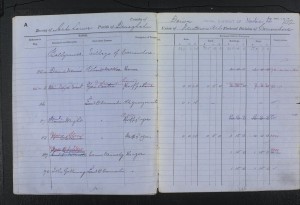 With the exception of Parish Registers and Civil Births, Deaths and Marriages, the Valuation Office Revision Books are amongst the most useful sources available to the Irish genealogist.
With the exception of Parish Registers and Civil Births, Deaths and Marriages, the Valuation Office Revision Books are amongst the most useful sources available to the Irish genealogist.
The Revision Books are a continuation of Griffith’s Valuation of Ireland – officially the Primary Valuation of Tenements. The purpose of this survey, conducted under the direction of Richard Griffith, was to assess the amount of tax every head of household should contribute towards the support of the poor and destitute in their parish. The Valuation was completed and published between 1847 and 1864. Dublin City and County were the first areas of Ireland to have their valuation completed. Griffith’s Valuation of Ireland records the town land address, the name of each occupier, the names of the immediate lessor (the landlord’s name), a brief description of the landholding, the number of acres of land in each holding, the value of buildings and land for taxation purposes, together with the overall valuation of each holding.
Griffith’s Valuation can be searched online at www.findmypast.ie and www.askaboutireland.ie/griffith-valuation/
The Revision Books are manuscript copies of the original valuation, which record any changes to the ownership, occupancy, size or value of a holding. The first revisions of Griffith’s Valuation of Ireland usually took place within a couple of years of the original publication, but in some instances the time lag between the publication of Griffiths and the first Revision Book entry can be as much as five years. Thereafter, inspections and revisions commonly occurred every two or three years, although in more remote areas this could be less frequent and in cities the revision took place annually.
The illustration shows a page from a Revision Book from Northern Ireland. Revisions to any of the entries, such as the change of name of the occupier of a landholding, a landholdings owner, value, etc., are accompanied by the date that the Valuation Office were informed of the change in circumstances. The date is usually written in the same colour ink as the change, making it possible to establish when a change was recorded.
Revision Books are especially useful in tracing the occupancy of land of families in rural areas and can often establish approximate dates of death and emigration (when a property passed from one generation to the next) or when a family purchased their landholding from its owner. To use the Revision Books a confirmed address has to be established, either from Griffith’s Valuation, the 1901/1911 Censuses of Ireland or through personal knowledge and in the case of cities, a street address is vital. Civil birth, marriage and death records can also provided townland or street addresses.
The Revision Books contain all amendments to tenements and landholdings in Ireland from the late 1850s, early 1860s, until the abolition of domestic rates in Ireland in the 1970s. The Revision Books are still in use for business premises.
Revision Books for the twenty-six counties of Ireland can currently only be inspected in person at the Valuation Office in Dublin – www.valoff.ie Images of the Revision Books for the six counties of Northern Ireland from 1864 to 1933 have been digitised and can be manually searched and downloaded from the website of the Public Record Office of Northern Ireland – www.proni.gov.uk Records after the 1930s can be inspected in person at PRONI. The online PRONI collection has been published by Ancestry and can be searched by name, as well as browsed by place.
If you are interested in consulting a Revision Book for a particular townland in the 26 counties of Ireland, but cannot visit the Valuation Office, you can order copies of the book you are interested in using the Timeline Genealogy Clerk service.
